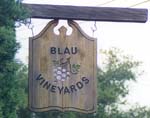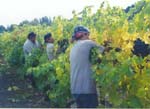Special Feature: Products Sally Recommends
Napa and Sonoma Grape Crush
 The year round process of growing grapes to make wine culminates in the crush. Anytime from late August to October the grape sugar level, or brix, reaches the perfect stage. This is different for each grape varietal. Champagne requires the lowest sugar level at 17; therefore, it is the first grape to be picked. Chardonnay comes next with a 22 brix and reds last with 24. This tells the vintners it is time to pick the grapes. Known as "the crush," this is a wonderful and busy time of the year in the Napa Valley, Sonoma County or any grape region in the world. In the Napa Valley gondolas that are pulled by tractors and full of freshly picked grapes move up and down Highway 29 and Highway 128 on their way to the wineries to be processed.
The year round process of growing grapes to make wine culminates in the crush. Anytime from late August to October the grape sugar level, or brix, reaches the perfect stage. This is different for each grape varietal. Champagne requires the lowest sugar level at 17; therefore, it is the first grape to be picked. Chardonnay comes next with a 22 brix and reds last with 24. This tells the vintners it is time to pick the grapes. Known as "the crush," this is a wonderful and busy time of the year in the Napa Valley, Sonoma County or any grape region in the world. In the Napa Valley gondolas that are pulled by tractors and full of freshly picked grapes move up and down Highway 29 and Highway 128 on their way to the wineries to be processed.
The wineries entertain guests in celebration of the crush, many grape pickers flood the valley looking for work and the aroma of freshly picked grapes permeates the valley. This smell comes from the grape skins that are left on the valley floor after the grapes are crushed.
 During the 1998 crush I visited the Blau Vineyard in Knight's Valley, a prime red grape growing area, on the day their Merlot grapes were being picked. Men and women grape pickers, some with bandannas covering their mouths and noses from the dust, stood on either side of the grape vines. Each had a grape knife and a plastic crate. They worked quickly because time is money in this business. The workers are paid by the weight of the grapes. And although there are some mechanical picking in the Napa Valley, most is still done by hand.
During the 1998 crush I visited the Blau Vineyard in Knight's Valley, a prime red grape growing area, on the day their Merlot grapes were being picked. Men and women grape pickers, some with bandannas covering their mouths and noses from the dust, stood on either side of the grape vines. Each had a grape knife and a plastic crate. They worked quickly because time is money in this business. The workers are paid by the weight of the grapes. And although there are some mechanical picking in the Napa Valley, most is still done by hand.
The full, dark red cut grapes were loaded into large metal gondolas that drove up and down each aisle. When they were filled, the driver hooked the gondolas to the truck. Then he and I got into a pickup truck and we were off to Sterling Vineyards in Calistoga, a premium winery that buys all of the Blau Ranch grapes.
 When we reached the winery, the gondolas were unhooked from the truck and the full gondola was weighed with the known weight of the gondola then subtracted from the total weight to derive the grape tonnage.
When we reached the winery, the gondolas were unhooked from the truck and the full gondola was weighed with the known weight of the gondola then subtracted from the total weight to derive the grape tonnage.
This is the moment for which the grower has been waiting. He will be told the yield of his grapes and by knowing the price he has agreed to in advance; he can then determine his profit (or loss) for the year.
 Napa crushed 70,690 tons of wine grapes in 1998 while Sonoma County (District 3) crushed 93,947 tons of wine grapes. The price of Napa and Sonoma grapes was up 11% and 10% respectively in 1998 in spite of the fact that overall grape prices and tonnage was down for the state slightly. Average Napa price per ton was $1906 and Sonoma was $1733 (Final Grape Crush Report, California Department of Food and Agriculture). Part of this was due to the El Nino rains that battered the Valley's harvest and the mildew that often follow the rains, causing a 30% drop in production from 1997's record harvest. Grape prices also depend on weather conditions, phyloxella (or other damage by insects) and management of the vines as well as demand for the wine and market demands.
Napa crushed 70,690 tons of wine grapes in 1998 while Sonoma County (District 3) crushed 93,947 tons of wine grapes. The price of Napa and Sonoma grapes was up 11% and 10% respectively in 1998 in spite of the fact that overall grape prices and tonnage was down for the state slightly. Average Napa price per ton was $1906 and Sonoma was $1733 (Final Grape Crush Report, California Department of Food and Agriculture). Part of this was due to the El Nino rains that battered the Valley's harvest and the mildew that often follow the rains, causing a 30% drop in production from 1997's record harvest. Grape prices also depend on weather conditions, phyloxella (or other damage by insects) and management of the vines as well as demand for the wine and market demands.
If you have a chance to visit a wine-growing region during the crush, be sure to take advantage of this magical time of year in the life cycle of grapes.
Note: This information was accurate when it was published. Please be sure to confirm all rates and details directly with the businesses in question before making your plans.



